Oyster Knife Blades
John McCabe
The blade of an oyster knife must be straight and true, elegantly
sleek, fairly thin and more or less narrow, so that it can slip
between the shell halves of the oyster fortress and seek the
adductor muscle without damaging the oyster's tender mantle flesh
or organs. Since the delicate adductor muscle should be cut rather
than torn, the blade's edge must be somewhat sharp. Simultaneously
the blade must be capable of sustaining the torque caused by
some prying and twisting and/or the punishment of chipping and
chopping. Its tip sector, particularly the so called point,
must be strong as an ox, yet as insidious as a rattlesnake. There
are several blade designs which optimize the opening of an oyster
when utilizing a particular opening method. Most designs are
pictured and described in the gallery section of the introduction
to oyster
knives. The following text briefly discusses the steel types
that are used and why (as well as those that are not - and why
not). For a knife-maker, choosing and working the proper type
of steel, be it stainless or carbon steel, goes a long way in
solving the complex equation that ultimately adds up to a perfect
oyster knife.
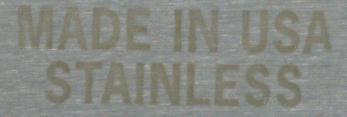 * Stainless Steel
* Stainless Steel
Chefs and meat-cutters are not fooled by blanket terms like "stainless",
because they know that the term covers many steel grades, everything
from very good to very poor. The term "stainless" always
managed to give me that fuzzy "quality feeling" for
many years when purchasing various types of knives. I've since
learned that the plain term "stainless" in itself is
rather meaningless. In the cutlery industry the liberal use of
this term has become very fashionable as a highly effective marketing
buzz word that sells.
There are more than 100 different types
of stainless steel. Both stainless and carbon steel are ordered
in various parts of the world by special code-systems. Here are
some examples: In the United States and a few other countries,
the A.I.S.I. system is preferred. The Germans work with W.Nr.
(Werkstoffnummer meaning industrial material number) and DIN
numbers. Japan uses the J.I.S. coding system. Additionally there
exists a U.N.S. (Unified Numbering System). For instance, the
AISI code of an exquisite stainless steel alloy for oyster knives
and many other types of cutlery is called 440 C. The Germans
will reference that same code as W.Nr. 1.4125 and DIN
X105CrMo17, while the Japanese will call it SUS 440 C.
The UNS coding system will reference this type of stainless as
S 44004.
 Knowing
that these cryptic looking codes may designate some "good
stuff" might prompt us to open our kitchen drawers and take
a closer look at some of our "silverware" and the abundance
of other utensils marked "stainless". Unfortunately,
those mysterious codes are only rarely to be found. It really
gets interesting when we start waving a little magnet over all
those shiny utensils. Many will stick to it like glue while some
others will not respond at all.
Knowing
that these cryptic looking codes may designate some "good
stuff" might prompt us to open our kitchen drawers and take
a closer look at some of our "silverware" and the abundance
of other utensils marked "stainless". Unfortunately,
those mysterious codes are only rarely to be found. It really
gets interesting when we start waving a little magnet over all
those shiny utensils. Many will stick to it like glue while some
others will not respond at all.
Instead of "stainless", some of our knives may stamped
or chemically etched with terms like INOX or Edelstahl
- Rostfrei. INOX is the abbreviation of the French term inoxydable
meaning non-oxydizing. Edelstahl - Rostfrei (or simply  "Rostfrei")
is the German designation for stainless steel. However, the term
Edelstahl alone does not necessarily qualify stainless
steel. It merely qualifies certain stainless and carbon steel
alloys as "noble" or "exquisite". Only by
adding the term Rostfrei (meaning free of rust)
is the Edelstahl alloy qualified as stainless steel.
"Rostfrei")
is the German designation for stainless steel. However, the term
Edelstahl alone does not necessarily qualify stainless
steel. It merely qualifies certain stainless and carbon steel
alloys as "noble" or "exquisite". Only by
adding the term Rostfrei (meaning free of rust)
is the Edelstahl alloy qualified as stainless steel.
Stainless steel contains a number of metallic alloying elements,
most notably chromium (10% +) which imparts high resistance
to heat and corrosion. Nickel (perhaps 8% +) is another important
ingredient in stainless steel to balance the iron. Other metallic
elements frequently used are molybdenum, selenium,
titanium, columbium, manganese (sometimes used
as a low cost substitute for nickel), and some others. The manufacturing
process of stainless steel differs considerably from that of
typical carbon steel. Comparatively, stainless steel is also
rather valuable. A local scrap metal dealer will pay a guy with
a big pick-up truck load full of old, dented up stainless steel
kitchen sinks much more money than the next guy pulling up on
the scales with a full load of rusty old bicycles, lawn mowers,
and a couple of dead washers and dryers. Subsequently, the "stainless
scrapper" might be having oysters on the half shell as an
entrée before fixin' his dinner while the "carbon
steel scrapper" will be lucky to receive enough money to
refill the gas tank on his truck. However, if a bunch of rusty
nails and brackets are still attached to those shiny old kitchen
sinks, the shrewd scrap dealer will not be so pleased. He will
classify the stainless load as "dirty" because of the
attached carbon steel and will consequently pay considerably
less than he would have for "clean stainless".
Incidentally, those old stainless kitchen
sinks that lucky scrap hauler brought in are interesting, because
they are non-magnetic while all of our stainless oyster knives
are very magnetic. Those sinks are made of so called austenitic
stainless steel, a special group of stainless steel. The
smart metal scrap dealer mentioned above might pay eight to ten
times more (80 to 90c per pound on the US West Coast in Dec.
2006) for this type of stainless than he would for magnetic stainless.
He may also consider some magnetic stainless grades as being
no more valuable than common carbon steel - rated at perhaps
just a few pennies per pound.
 In
terms of corrosion resistance, austenitic stainless is the best
stainless group of all. There are several types such as AISI
301, 302, 304, 309, 310 and others. 301 and 304 are common German
manufacturing choices for quality table forks, spoons and knives.
The respective formal code designations are X10CrNi18-8
and X5CrNi18-10 which are sometimes stamped or etched
in abbreviated form as simply 18/8 or 18/10. However,
the knives in such quality sets are quite special, as the manufacturers
will use the non-magnetic 18/8 or 18/10 on the handle part and
choose a magnetic stainless on the blade portion (pictured
above). The reason for this extra step in the manufacturing
process is that the austenitic group of stainless is simply not
tough enough to serve as a quality knife blade. Our "silverware"
drawer may also feature some eating utensils with colorful plastic
handles that were usually made in a few highly industrious nations
in the Far East. They are also marked "stainless",
are highly magnetic, usually comparatively light weight, and
much more affordably priced than the German counterparts. These
utensils frequently (not always) constitute the opposite end
of the stainless quality spectrum which some folks refer to as
"cheap junk". This rather harsh qualification may have
been brought about by easily bent spoons or the tines of some
of the forks that soon look like they desperately need an appointment
at the orthodontist. In the end, however, that delicious oyster
stew will taste just as good with a cheap spoon as it would with
an expensive one.
In
terms of corrosion resistance, austenitic stainless is the best
stainless group of all. There are several types such as AISI
301, 302, 304, 309, 310 and others. 301 and 304 are common German
manufacturing choices for quality table forks, spoons and knives.
The respective formal code designations are X10CrNi18-8
and X5CrNi18-10 which are sometimes stamped or etched
in abbreviated form as simply 18/8 or 18/10. However,
the knives in such quality sets are quite special, as the manufacturers
will use the non-magnetic 18/8 or 18/10 on the handle part and
choose a magnetic stainless on the blade portion (pictured
above). The reason for this extra step in the manufacturing
process is that the austenitic group of stainless is simply not
tough enough to serve as a quality knife blade. Our "silverware"
drawer may also feature some eating utensils with colorful plastic
handles that were usually made in a few highly industrious nations
in the Far East. They are also marked "stainless",
are highly magnetic, usually comparatively light weight, and
much more affordably priced than the German counterparts. These
utensils frequently (not always) constitute the opposite end
of the stainless quality spectrum which some folks refer to as
"cheap junk". This rather harsh qualification may have
been brought about by easily bent spoons or the tines of some
of the forks that soon look like they desperately need an appointment
at the orthodontist. In the end, however, that delicious oyster
stew will taste just as good with a cheap spoon as it would with
an expensive one.
The stainless used in most quality American
oyster knives (and many quality cutting knives) belongs in another
very important steel group called ferritic stainless steel.
It is very strong, durable, and highly corrosion resistant. As
mentioned earlier, quality American oyster knives usually feature
the AISI type 440 C. The "C" is important as there
are other 440 grades (such as 440 A and 440 B, considered much
inferior by many in the knife making process). There are also
a few other, more exotic grades that are equal or superior to
440 C.
There is yet a third important group that
is called martensitic stainless steel. Like ferritic stainless,
martensitic stainless is also magnetic, yet considered not as
"good" as ferritic stainless. AISI 410 is famous in
this martensitic group and is frequently used in the industry
for applications such as corrosion resistant bins, plates, and
liners.
Hence, depending on the alloy ("metal
mix") chosen and the way the steel is subsequently worked,
many different grades of stainless steel can be produced, each
with its own special characteristics. Knife manufacturers can
subject a particular alloy to various heating, cooling, and beating
(for tempering) techniques to further enhance its qualities.
Among the other "ingredients", stainless steel also
contains a small amount of carbon. Some knife-makers tout "high
carbon" stainless steel, suggesting the best of both worlds:
stainless, yet "tough as nails", much like a high quality
traditional carbon steel knife. "High carbon" is a
rather non-descript, unfixed measure which simply implies "extra
hard and durable". However, this claim is frequently not
some lame marketing gimmick, as higher carbon content can be
most desirable and is not easily achieved in stainless. Chromium
is one of the complicating factors. All of that chromium floating
around in that hot stainless steel "soup" really loves
carbon. This chemical affinity to carbon leads to absorption,
oxidization and the precious chromium may end up going into the
slag (slag or "scoria" is the refuse associated with
the melting of metals).
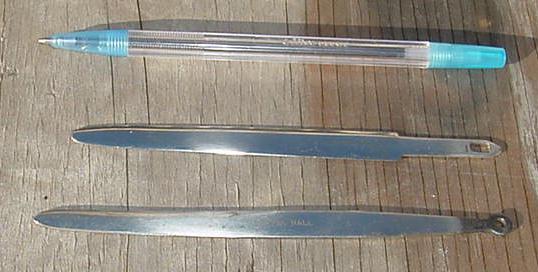
Image above: The broader upper blank
is a cheap stainless blank made in China (13 mm, 10 g). The more
slender lower blank is a carbon steel blank once made by Carvel
Hall (13.6 mm, 15 g). It is the blank that fits the famed Chesapeake
stabber design (see gallery).
Blanks made for use with wooden handles are commonly keyed near
or at the end of the tang for a steel or yellow brass securing
pin.
Since stainless steel, regardless of the
grade quality, is not a cheap material, it is also a great place
for some manufacturers to start cutting corners. A cheaply made
alloy will usually result in a poor blade that will bend like
a "wet noodle" once exposed to a relatively small amount
of torque. The tang, stashed
away inside the oyster knife's handle, may end up being entirely
inadequate to support the blade under heavy use - all to just
save some of that semi-precious stainless steel on a large production
run and turn out a nice looking "oyster knife" for
the proverbial "five bucks" - and still carve out a
healthy profit.
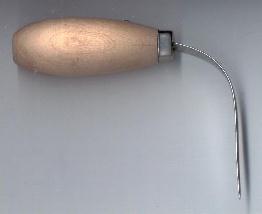 Inset
image: The pictured "oyster knife" originally looked
real nice at first glance. It was made in China and very low
priced when I purchased it new (cost me less than 5 bucks). The
handle seems to be made of some type of oak and is quite well
made. The tang locking pin is made of some brass alloy, also
acceptable. The blade is marked "stainless". However,
the horizontal inspection of the knife's blade revealed a very
slight wave and, in the plane of the handle, the blade was angled
downward just a tad. I checked the flex in the blade and it struck
me as quite high, particularly where it met the tang leading
into the handle. I then donned my shucking gloves and proceeded
to bend that blade down and around with much ease. As a layperson
in metallurgy I can only suspect that the grade of stainless
used was very inferior and the tang highly inadequate, thus nullifying
the rather acceptable quality value of the handle and pin alloy.
Inset
image: The pictured "oyster knife" originally looked
real nice at first glance. It was made in China and very low
priced when I purchased it new (cost me less than 5 bucks). The
handle seems to be made of some type of oak and is quite well
made. The tang locking pin is made of some brass alloy, also
acceptable. The blade is marked "stainless". However,
the horizontal inspection of the knife's blade revealed a very
slight wave and, in the plane of the handle, the blade was angled
downward just a tad. I checked the flex in the blade and it struck
me as quite high, particularly where it met the tang leading
into the handle. I then donned my shucking gloves and proceeded
to bend that blade down and around with much ease. As a layperson
in metallurgy I can only suspect that the grade of stainless
used was very inferior and the tang highly inadequate, thus nullifying
the rather acceptable quality value of the handle and pin alloy.
So what does the word "stainless"
really tell the "Joe Average" consumer much like me?
Not much unfortunately, as nobody can judge the quality of the
stainless steel a knife maker used by just looking at the blade
of an oyster knife (or any knife for that matter).  All stainless means is that the knife
blade will probably stay nice and shiny looking and hopefully
will not readily stain or rust - no more, no less. It will, however,
certainly stain and pit to some extent if improperly cared for.
I've also learned that carbon steel blades which naturally rust
are by no means necessarily "cheap junk" - no more
than cast iron pots and pans are to be quickly dismissed as antiquated
and inferior to those shiny stainless steel pots. In fact, certain
types of knives made of special high carbon steel alloys can
prove to be equal or superior to any stainless steel knife -
and incidentally, quite a number of food dishes will always taste
better when cooked in old-fashioned cast iron pots and pans rather
than their stainless counterparts.
All stainless means is that the knife
blade will probably stay nice and shiny looking and hopefully
will not readily stain or rust - no more, no less. It will, however,
certainly stain and pit to some extent if improperly cared for.
I've also learned that carbon steel blades which naturally rust
are by no means necessarily "cheap junk" - no more
than cast iron pots and pans are to be quickly dismissed as antiquated
and inferior to those shiny stainless steel pots. In fact, certain
types of knives made of special high carbon steel alloys can
prove to be equal or superior to any stainless steel knife -
and incidentally, quite a number of food dishes will always taste
better when cooked in old-fashioned cast iron pots and pans rather
than their stainless counterparts.
Hence, when it comes down to the term stainless
in knives, it all comes down to that really scary word in business
and politics called "trust". Knowing who made that
knife and where it was made certainly helps. I've resorted to
only buying knives of any type from trusted names in the industry
made in countries renowned for their knife steel quality. American,
German, Japanese, French, Swiss, Swedish, and English knife makers
have long held a high standing in terms of quality and these
places of origin largely still hold great meaning.
Care note: Never soak stainless steel
blades in a bleach water solution, as it may irreparably stain
and pit the metal. Hence, the chlorine content in public swimming
pools for instance calls for a special type of stainless in those
environments. Conventional carbon steel products (such as steel
wool pads) should not be used to clean stainless, as they can
introduce carbon steel rust stains. Abrasive kitchen powder cleaners
should be avoided, particularly since they will dull the shiny
finish of a fine blade. Some soap and hot water work best.
* Carbon Steel
Carbon steel is very common. 90%+ of all the steel produced is
considered carbon steel. Steel is essentially an alloy of iron
and carbon, usually produced with the addition of varying amounts
of other metallic element types. Some steels are commercially
called irons although they may contain more carbon than conventional
steels. On the other hand, wrought iron contains merely a few
hundredths of one percent of carbon while most types of steel
contain anywhere from .04% to 2.25% carbon. What makes many a
carbon steel knife so very special is the particular alloy that
was employed and the way it was fabricated. The proper alloy
usually features a larger dose of molybdenum, vanadium,
tungsten, or other metallic alloying elements than used
in the production of conventional carbon steel alloys. The conventional
types serve well for construction purposes, ships, paper clips,
and countless other applications like "tin" cans (which
consist of 99% low end hot- or cold-rolled carbon steel that
was passed through a bath of molten tin).
High quality carbon steel oyster knives used to be the rule in
the oyster industry. Carbon steel has been around for many centuries
while stainless steel was first developed between 1903 and 1912.
The immense value of stainless steel in countless applications
was quickly recognized by many industries. In the decades to
follow, the inherent expense and difficulty of producing stainless
steel progressively diminished. The stainless alloys also became
much stronger, thus making them also ideally suited for fine
cutlery. By the 1960s and 70s, the naturally beautiful and easily
cared for stainless steel products already ruled the cutlery
industry and continue to do so today. Although stainless rules,
it certainly does not rule absolutely. Given a choice, many chefs
would never trade some of their high quality carbon steel knives
for any stainless steel knife. Quality carbon steel knives are
very hard and will hold a razor's edge for a long time, longer
than most (if not all) stainless counterparts.
Similar sentiments exist among many oyster
industry professionals. Although the adductor muscle of an oyster
is exceedingly strong, it cuts almost like butter. Hence, the
edge of an oyster knife does not need to be sharper than a butter
knife. Instead, a sleek blade with great strength and high durability,
perfectly matched with a good handle, is of paramount importance.
The so called stabber knives, for instance, feature narrow, flat
blades which must be able to sustain a fair amount of prying
and twisting torque - not just with one batch of oysters, but
hundreds or even thousands. No stainless alloy will ever surpass
a high quality carbon steel blade in performance along those
lines. Most oystermen also don't care if the high carbon steel
blade shows some staining after years of use. That oyster knife
does not need to be pretty - no more than oysters need to win
a beauty contest. The thought of salt water meeting carbon steel
conjures up visions of rusty old boat trailers held together
by little more than a prayer. The carbon steel alloys used in
oyster knives don't "vaporize" into a pile of rust
after a brush with salt water. On the contrary: I have a dozen
different oyster knives of this steel genre, some aged 60 years
or more, which have seen more than their fair share of use (and
abuse) and no doubt still work every bit as well today as they
did the day they were made. I choose to view the few stains they
bear not as flaws, but rather as hard earned evidence of "good
character".
Old and trusted names in the American fish
and shellfish knife industry, names like R. Murphy and Dexter-Russell
for instance, feature a large selection of knives with stainless
and carbon steel blades. For good reasons, some of their knives
are only available in carbon steel.
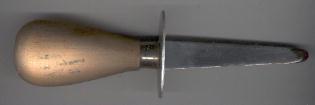 Inset
image: Here's an "oyster knife" of unknown manufacturing
origin that looks acceptable at first glance, yet fails the quality
test. The handle is well formed in the classic pear shape and
the wood quality, aside from some stains, appears to be quite
good. The manufacturer added a hand guard. Oddly, it consists
of an oval piece of aluminum. Initially, the blade looked bright
and shiny, much like
Inset
image: Here's an "oyster knife" of unknown manufacturing
origin that looks acceptable at first glance, yet fails the quality
test. The handle is well formed in the classic pear shape and
the wood quality, aside from some stains, appears to be quite
good. The manufacturer added a hand guard. Oddly, it consists
of an oval piece of aluminum. Initially, the blade looked bright
and shiny, much like 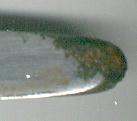 stainless
steel. In time, some rust spotting started to develop on the
ferrule and the blade. Soon, small flakes of what appears to
be some chrome or nickel plating started flaking off around the
tip. The subsequently exposed carbon steel underneath quickly
proved to be a highly corrosive grade.
stainless
steel. In time, some rust spotting started to develop on the
ferrule and the blade. Soon, small flakes of what appears to
be some chrome or nickel plating started flaking off around the
tip. The subsequently exposed carbon steel underneath quickly
proved to be a highly corrosive grade.



